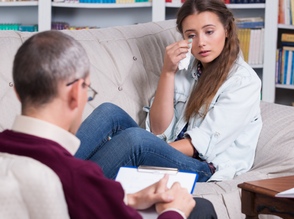Adolescence is an exciting time, full of physical, mental and emotional changes: Sexual attraction grows; we become aware of our ability to think for ourselves and start to see that we are unique individuals. It can also be a time of intense emotional upheaval.
With all these changes, the emotional lives of teenagers can be a rollercoaster of ups and downs, a tough ride for teens and their parents. A recent National Institute of Mental Health study found that depression is far more common among teenagers than many suspect, with over 10% reporting feelings of depression at any one time.
Depressed individuals lose interest in activities that were once pleasurable to them, feel tired and have low energy, have difficultly with concentration, memory and decision-making. They may be irritable or restless, have changes in sleep behavior that range from insomnia to excessive sleeping.Everything feels painful, difficult, or requiring too much effort or energy.
Their eating behaviors may change. People who are depressed may overeat or have a loss of appetite and weight loss. They often have physical complaints including aches, pains and digestive problems that do not respond to treatment.
People with depression can find it difficult to function at home, at work, or in school and in social settings. Everything feels painful, difficult, or requiring too much effort or energy. They may contemplate or attempt suicide.
Depression may occur only once, or it may recur periodically. More than half of patients with one episode of depression will have another at some point. And 80% of patients who have two episodes will have another recurrence later in their lives. Depression is highly Prevalence. Recent estimates suggest that 16.6% of adults have been depressed at some point.
People with depression are typically treated with psychotherapy and/or medication. In some persistent cases, electroconvulsive therapy and transcranial magnetic stimulation are used.
They surveyed over 10,000 parents and adolescents to explore the rates of depression, the degrees to which symptoms interfered with teens' functioning, the risk of suicide, and the types of treatment adolescents tended to receive.
The study found that major depressive disorder was common in the adolescent population. Eleven percent reported symptoms of depression at any time, while 7.5% reported depression during the preceding year.Thirty percent of depressed teens reported some kind of suicidal thoughts, with 10% reporting an actual suicide attempt.
Girls were more likely than boys to experience a major depressive disorder — two to three times more likely. And they were almost four times more likely to have severe depression.
The risk of developing depression in adolescence increases with age. Severe depression was almost four times higher in older rather than younger teens.
Family income, race, whether parents were divorced, or geographical differences such as urban vs. rural location seemed to have no effect on these numbers. What did make it more likely a teen would develop depression were the presence of anxiety and behavioral disorders, such as ADHD or conduct disorders.
Many of the teens who were diagnosed with major depression indicated that they were significantly disabled by their condition. It left them less able to participate in their age-appropriate roles and activities at home, school, and in social settings. Thirty percent of depressed teens reported some kind of suicidal thoughts, with 10% reporting an actual suicide attempt.
The majority, 60%, received treatment for their depressive disorder. However, only a third of depressed teens received either disorder-specific treatment or treatment from a mental health provider. This treatment gap was even greater for minority youth.
The researchers concluded that depression is common in adolescence and often leads to mental and physical health challenges that persist into adulthood and impair long term social/vocational/economic success and quality of life. Teenage girls are at particularly high risk, they found, and should be high priority targets of early treatment and prevention.Teens are often moody, but this isn't a reason not to be concerned if you feel your child may be depressed.
Teens are often moody, but this isn't a reason not to be concerned if you feel your child may be depressed. If your teenager starts sleeping or eating a great deal more or less than usual; if he or she seems listless and uninterested in things that used to give pleasure, try to ask him or her about it. You may want to look into treatment options in your area or check with your family doctor.
Therapy and antidepressant medication can make a big difference in easing depression. Since depression can be recurring, it's particularly helpful if teens learn early that they can take steps to improve their mood and feel better about life.
Suicide is the third leading cause of death among U.S. teenagers, so identifying and treating depressed adolescents is a potentially life-saving priority. We need public health policies that emphasize early identification and prevention of depression, the researchers say. They further note that there are validated screening tools that can be used at schools and in primary care health settings to identify at-risk teens and make appropriate interventions and referrals.
Parents who notice behavior changes in their teens, including worrisome trends in their school and social functioning, may wish to consult their health care providers to determine whether depression may be playing a role in their children’s lives.
The study is published in Journal of the American Academy of Child and Adolescent Psychiatry.





